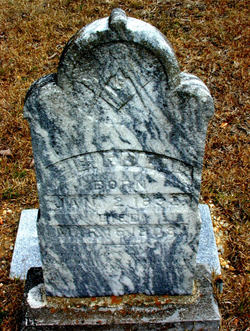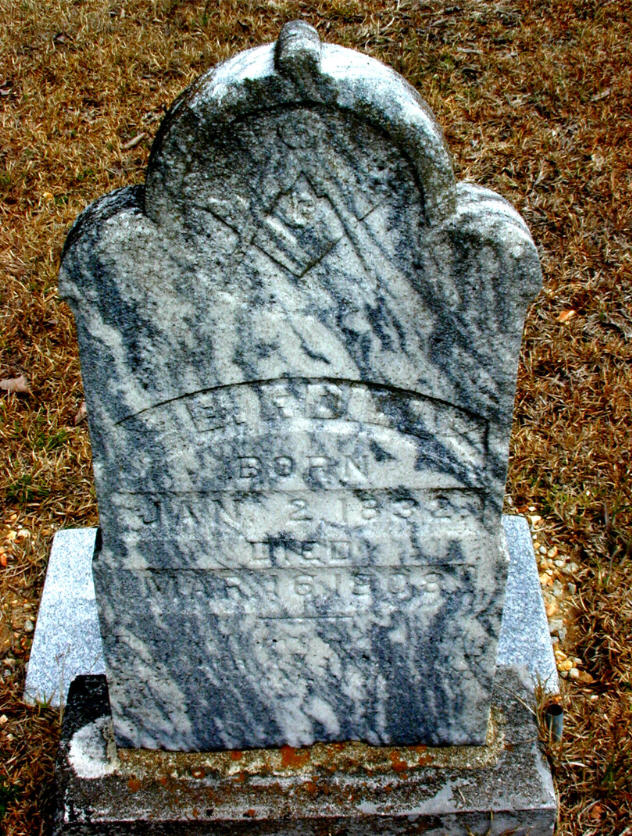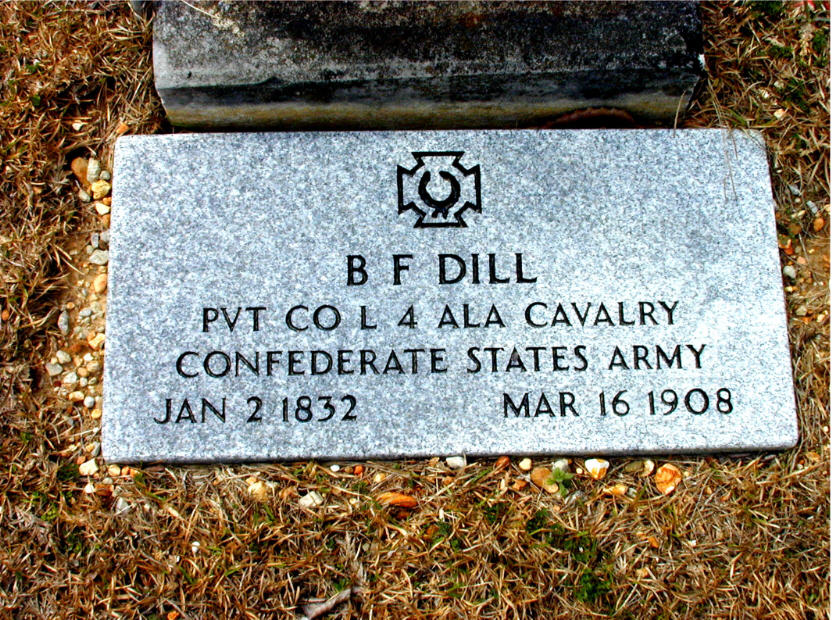Married Eliza C. Scruggs - Abt 1878
Married Lucy Caroline Galey - Mar 20, 1887 in Lawrence Co., AL
Confederate Military Service:
Ben and his brother Partain mustered into the Confederate Army with Houston's Independent Cavalry Company at Cherokee, Franklin County, AL on Dec 21, 1861. Confederate calvary recruits had to provide their own horse, riding equipment and arms. Pistols and sabers were in short supply and most of Houston's troopers were armed with double barrel shotguns when they were inducted into the Confederate Army. Historically, this company was known as William Houston's Independent Cavalry Company and was also called the Franklin Scouts.
The Dill brothers were grandsons of Enoch Sparks, a South Carolina soldier in the War of 1812 and great-grandsons of John Sparks, a North Carolina officer in the Revolutionary War. Continuing family military traditions, Ben and Partain entered the Confederate Army with their Sparks Family cousins Carol Jasper McRight, Lemuel M. McRight, Newton J. McRight, William Houston McRight, James M. Nelson, John Calhoun Nelson and Thomas Jefferson Nelson. After induction, Houston's Company rode to Florence, Lauderdale County, AL to begin training in calvary tactics and to await transportation to their first battle.
At Florence, they met another Alabama company that was also recruited during the Spring, Summer and Fall with induction into the Confederate Army on Dec 17, 1861. Captain David Hubbard raised his "Company of Alabama Rangers" from Lawrence, Morgan, Walker and Lauderdale Counties and in the Fall of 1862 they became the foundation of Company K, Roddy's Fourth Alabama Cavalry.
In late Jan 1862, Houston's and Hubbard's Companies boarded riverboats at Florence for a trip down the Tennessee River to Fort Henry, TN. Shortly after arrival, both companies were ferried to the west side of the river to provide cavalry support for the 27th Alabama and 15th Arkansas Infantry Regiments at Fort Heiman, KY. Fort Heiman was an unfinished earthwork with no artillery on a 200 foot high bluff above the Tennessee River just south west of Fort Henry. Confederate commanders feared that if Fort Heiman was captured by the enemy, Union gunners could fire directly into Fort Henry from the heights. Before sunrise on Feb 5th, with the Tennessee River rising rapidly, Fort Henry flooding and the approaches to Fort Heiman also flooded, Confederate commanders moved the 27st Alabama and 15th Arkansas back to the east side of the river. Union troops could easily surround and take the poorly armed infantry regiments prisoner but at least the calvary could ride away and escape. Successful defense of a flooded Fort Henry was unlikely and the defense of Fort Heiman would have to depend on the rising flood waters and 62 troopers from Captain Houston's Company, 83 troopers from Captain Hubbard's Company and 40 locals from Calloway County, KY known as "Padgett's Spy Company".
During the day of Feb 5th, General Grant issued "Field Order Number 1" to put the Union Army and Navy into position to attack Fort Henry and Fort Heiman. After dark, river transports began offloading Union troops 5 miles north of Fort Heiman at Pine Bluff Landing and 6 miles north of Fort Henry at Bailey's Landing. Union transports were still offloading troops and equipment less than 2 hours before the planned attack time of 11:00 am on Feb 6, 1862.
At 11:00 am on Feb 6th, 5300 men of BGen Charles F. Smith's Second Division began the march south to Fort Heiman with cavalry leading, BGen Lew Wallace's Brigade and BGen Eleazer A. Paine's Brigade following with Company A, 1st Illinois Light Artillery bringing up the rear. This attack formation included 5 regiments of infantry, 3 companies of cavalry, an artillery battery and a gunboat escort. Houston, Hubbard and Padgett, the Confederate defenders of Fort Heiman, were outnumbered more than 28 to 1 and heavily outgunned with shotguns against rifles and artillery. Captain Padgett's Mexican War experience and leadership provided the critical key to the survival of the Fort Heiman defenders. The night before and into the morning, Captain Padgett's Spy Company watched as Union troops offloaded at Pine Bluff Landing. Padgett's intelligence indicated the any defense of Fort Heiman would bring certain death or capture. When the Second Division cavalry advance arrived at Fort Heiman, the defenders had wisely jumped the creek on the south-west side of the fort and retreated west toward Paris, TN.
During February, Houston's and Hubbard's Companies moved from Paris, TN to Cayce's Station, KY with Lt. Colonel John H. Miller's 1st Mississippi Cavalry Battalion to protect the Mobile and Ohio Railroad from attack during the Confederate retreat from Columbus, KY.
In early April 1862, Houston's entire company was transferred to become Company H, Claiborne's Cavalry Regiment (historically known as 1st Company H, 1st Confederate Cavalry). Because of a mix-up in orders, Lt. Colonel John H. Miller brought Houston's and Hubbard's Companies along with his 1st Mississippi Cavalry Battalion as escorts for General Polk's Division to the Shiloh Battlefield. When the Confederate High Command discovered that 2 of Col. Claiborne's companies were at Shiloh without their commander or proper orders, Houston's and Hubbard's Companies were immediately separated from the 1st Mississippi Cavalry Battalion and fought under General Bragg during the Battle of Shiloh.
Shortly after Shiloh, Captain William Houston resigned his command and Ben Dill's company transferred to Company L, 4th Alabama (Roddey's) Calvary in the fall of 1862. He served with the 4th Alabama Calvary through the 1863 battles of Streight's Raid, the Chickamauga and Chattanooga Campaigns, the 1864 battles of Brice's Crossroads, Tupelo, the Atlanta Campaign, Forrest's Northern Alabama and Middle Tennessee Raid, Hood's Tennessee Campaign and defense against General James Wilson's Alabama Raid in 1865.
Married Eliza C. Scruggs - Abt 1878
Married Lucy Caroline Galey - Mar 20, 1887 in Lawrence Co., AL
Confederate Military Service:
Ben and his brother Partain mustered into the Confederate Army with Houston's Independent Cavalry Company at Cherokee, Franklin County, AL on Dec 21, 1861. Confederate calvary recruits had to provide their own horse, riding equipment and arms. Pistols and sabers were in short supply and most of Houston's troopers were armed with double barrel shotguns when they were inducted into the Confederate Army. Historically, this company was known as William Houston's Independent Cavalry Company and was also called the Franklin Scouts.
The Dill brothers were grandsons of Enoch Sparks, a South Carolina soldier in the War of 1812 and great-grandsons of John Sparks, a North Carolina officer in the Revolutionary War. Continuing family military traditions, Ben and Partain entered the Confederate Army with their Sparks Family cousins Carol Jasper McRight, Lemuel M. McRight, Newton J. McRight, William Houston McRight, James M. Nelson, John Calhoun Nelson and Thomas Jefferson Nelson. After induction, Houston's Company rode to Florence, Lauderdale County, AL to begin training in calvary tactics and to await transportation to their first battle.
At Florence, they met another Alabama company that was also recruited during the Spring, Summer and Fall with induction into the Confederate Army on Dec 17, 1861. Captain David Hubbard raised his "Company of Alabama Rangers" from Lawrence, Morgan, Walker and Lauderdale Counties and in the Fall of 1862 they became the foundation of Company K, Roddy's Fourth Alabama Cavalry.
In late Jan 1862, Houston's and Hubbard's Companies boarded riverboats at Florence for a trip down the Tennessee River to Fort Henry, TN. Shortly after arrival, both companies were ferried to the west side of the river to provide cavalry support for the 27th Alabama and 15th Arkansas Infantry Regiments at Fort Heiman, KY. Fort Heiman was an unfinished earthwork with no artillery on a 200 foot high bluff above the Tennessee River just south west of Fort Henry. Confederate commanders feared that if Fort Heiman was captured by the enemy, Union gunners could fire directly into Fort Henry from the heights. Before sunrise on Feb 5th, with the Tennessee River rising rapidly, Fort Henry flooding and the approaches to Fort Heiman also flooded, Confederate commanders moved the 27st Alabama and 15th Arkansas back to the east side of the river. Union troops could easily surround and take the poorly armed infantry regiments prisoner but at least the calvary could ride away and escape. Successful defense of a flooded Fort Henry was unlikely and the defense of Fort Heiman would have to depend on the rising flood waters and 62 troopers from Captain Houston's Company, 83 troopers from Captain Hubbard's Company and 40 locals from Calloway County, KY known as "Padgett's Spy Company".
During the day of Feb 5th, General Grant issued "Field Order Number 1" to put the Union Army and Navy into position to attack Fort Henry and Fort Heiman. After dark, river transports began offloading Union troops 5 miles north of Fort Heiman at Pine Bluff Landing and 6 miles north of Fort Henry at Bailey's Landing. Union transports were still offloading troops and equipment less than 2 hours before the planned attack time of 11:00 am on Feb 6, 1862.
At 11:00 am on Feb 6th, 5300 men of BGen Charles F. Smith's Second Division began the march south to Fort Heiman with cavalry leading, BGen Lew Wallace's Brigade and BGen Eleazer A. Paine's Brigade following with Company A, 1st Illinois Light Artillery bringing up the rear. This attack formation included 5 regiments of infantry, 3 companies of cavalry, an artillery battery and a gunboat escort. Houston, Hubbard and Padgett, the Confederate defenders of Fort Heiman, were outnumbered more than 28 to 1 and heavily outgunned with shotguns against rifles and artillery. Captain Padgett's Mexican War experience and leadership provided the critical key to the survival of the Fort Heiman defenders. The night before and into the morning, Captain Padgett's Spy Company watched as Union troops offloaded at Pine Bluff Landing. Padgett's intelligence indicated the any defense of Fort Heiman would bring certain death or capture. When the Second Division cavalry advance arrived at Fort Heiman, the defenders had wisely jumped the creek on the south-west side of the fort and retreated west toward Paris, TN.
During February, Houston's and Hubbard's Companies moved from Paris, TN to Cayce's Station, KY with Lt. Colonel John H. Miller's 1st Mississippi Cavalry Battalion to protect the Mobile and Ohio Railroad from attack during the Confederate retreat from Columbus, KY.
In early April 1862, Houston's entire company was transferred to become Company H, Claiborne's Cavalry Regiment (historically known as 1st Company H, 1st Confederate Cavalry). Because of a mix-up in orders, Lt. Colonel John H. Miller brought Houston's and Hubbard's Companies along with his 1st Mississippi Cavalry Battalion as escorts for General Polk's Division to the Shiloh Battlefield. When the Confederate High Command discovered that 2 of Col. Claiborne's companies were at Shiloh without their commander or proper orders, Houston's and Hubbard's Companies were immediately separated from the 1st Mississippi Cavalry Battalion and fought under General Bragg during the Battle of Shiloh.
Shortly after Shiloh, Captain William Houston resigned his command and Ben Dill's company transferred to Company L, 4th Alabama (Roddey's) Calvary in the fall of 1862. He served with the 4th Alabama Calvary through the 1863 battles of Streight's Raid, the Chickamauga and Chattanooga Campaigns, the 1864 battles of Brice's Crossroads, Tupelo, the Atlanta Campaign, Forrest's Northern Alabama and Middle Tennessee Raid, Hood's Tennessee Campaign and defense against General James Wilson's Alabama Raid in 1865.
Gravesite Details
B.F. Dill has several different birth dates. The 1850, 1860, 1870 and 1880 U.S. Census shows 1835 as his birth year. The 1900 U.S. Census says Jan 1833. Only his Civil War pension application agrees with the 1832 on his headstone.
Family Members
-
Andrew C "A.C." Dill
1855–1934
-
![]()
Lora A Dill Byrd
1858–1923
-
![]()
Laura O. Dill Mansell
1859–1899
-
![]()
Benjamin Franklin "B.F." Dill Jr
1862–1941
-
![]()
Amos Jasper "Jake" Dill
1864–1940
-
Nancy M. Dill Fleming
1867–1909
-
Josephine Dill
1869–1880
-
![]()
Rebecca Ann Dill Owens
1871–1947
-
![]()
William Severe Dill
1879–1963
-
![]()
Alabama "Bama" Dill Kimbrough
1889–1963
-
![]()
Lucy C Dill Lindsey
1891–1969
-
![]()
Katy Dill Willis
1893–1965
-
![]()
Isaac Simpson Dill
1896–1980
Sponsored by Ancestry
Advertisement
Records on Ancestry
Advertisement


























